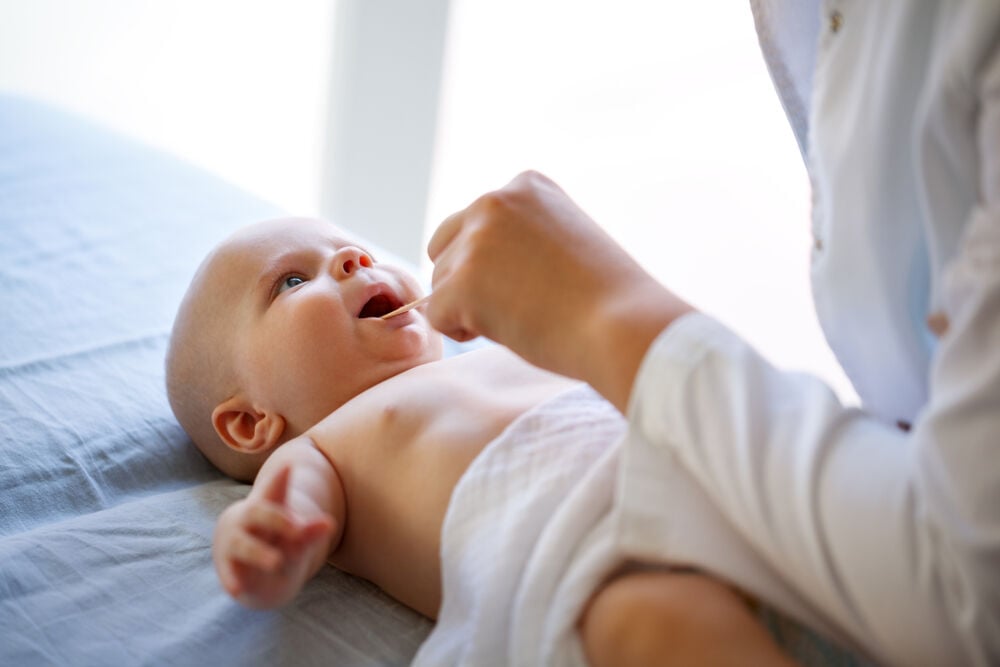When parents notice white or yellow bumps in the mouth of their baby, they often think the baby’s teeth are making an early entrance. These bumps are known as Epstein pearls and Bohn’s nodules and are completely normal. Read on to find out more about them.
-
Tracking cycle
-
Getting pregnant
-
Pregnancy
-
Help Center
-
Flo for Partners
-
Anonymous Mode
-
Flo app reviews
-
Flo Premium New
-
Secret Chats New
-
Symptom Checker New
-
Your cycle
-
Health 360°
-
Getting pregnant
-
Pregnancy
-
Being a mom
-
LGBTQ+
-
Quizzes
-
Ovulation calculator
-
hCG calculator
-
Pregnancy test calculator
-
Menstrual cycle calculator
-
Period calculator
-
Implantation calculator
-
Pregnancy weeks to months calculator
-
Pregnancy due date calculator
-
IVF and FET due date calculator
-
Due date calculator by ultrasound
-
Medical Affairs
-
Science & Research
-
Pass It On Project New
-
Privacy Portal
-
Press Center
-
Flo Accuracy
-
Careers
-
Contact Us
White Bumps in the Mouth: Can It Be Early Teething?

Every piece of content at Flo Health adheres to the highest editorial standards for language, style, and medical accuracy. To learn what we do to deliver the best health and lifestyle insights to you, check out our content review principles.
What are these whitish-yellow bumps in the mouth of a newborn?
When babies are a few months old, they often have white or yellow pimples in the mouth. These bumps appear on the upper palate and along the gum line. In this position, they can resemble baby teeth pushing through the gums.
While bumps in the mouth of a baby might seem worrisome, they are completely normal. Between 60 and 85 percent of babies experience Epstein pearls and Bohn’s nodules. They are also referred to as palatal cysts or gingival cysts, and they’re more common in some babies than others. They are more common in babies:
- Born before or on their due date
- Born to mothers who have already given birth to other children
- Who are heavier
These bumps are harmless and will usually resolve within a few weeks or months.
What causes bumps in the mouth of a baby?
This kind of benign mouth cyst in a baby develops during pregnancy. It’s completely normal, and there’s nothing that could have prevented it.
Around eight weeks into a pregnancy, the baby’s palate begins forming. Each maxillary process — the part that forms the upper jaw and associated features — expands laterally to form the baby’s upper palate. The two processes meet halfway, fusing with the smaller premaxillary process to form the nasal septum. By the fourth month, the palate is fully formed.
During this stage, the outer lining gets trapped between the palate and the nasal process. This forms cysts, called Epstein pearls, that are filled with keratin — the protein in nails and hair. This is why Epstein pearls are often compared to milia, which are similar white bumps on the baby’s face.
Bohn’s nodules are also white cysts filled with keratin. They are remnants of the salivary glands and can occur where the hard and soft palate meet and along the gums.

Take a quiz
Find out what you can do with our Health Assistant
To diagnose a cyst in the mouth or natal tooth or rule out other kinds of disease, it’s a good idea to have babies’ teeth and gums checked by a health care provider. Natal teeth are teeth that babies are born with.
Sometimes cysts in the mouth are signs of an infection like oral thrush, which is a yeast infection of the mouth. A pimple inside the mouth could be a dental lamina cyst, which is firm and usually larger than an Epstein pearl or Bohn’s nodule.
A blister inside the lip may be attached via a stalk to the lining of the gum. This is known as a congenital epulis. The bump could also be a congenital ranula — a translucent nodule on the floor of the mouth next to the tongue web.
To determine what kind of mouth cyst or blister inside the lip a baby might have, it’s advisable to ask a health care provider about it. The health care provider will usually need no lab work or imaging done to diagnose Epstein pearls. Some conditions look similar to Epstein pearls, and the health care provider may perform additional tests to confirm the cause.
How to treat cysts in the mouth of a baby
When it comes to gingival cysts, there is usually no treatment necessary. The bumps usually rupture on their own in the first weeks and months after birth. Sometimes, breastfeeding can help resolve gingival cysts, as the light friction when the baby suckles can painlessly rupture the Epstein pearls.
It can be tempting to touch or try to pop a cyst or Epstein pearl in a baby’s oral cavity. The cyst will likely go away on its own, so it’s best not to intervene. Popping or rupturing the cysts breaks the skin and presents an opportunity for infection. Because of this, it’s best to avoid touching a mouth cyst.
A white bump in the mouth of your baby is very likely normal. It’s probably an Epstein pearl or Bohn’s nodule, which are benign and will resolve in a few weeks. If it persists past the first month, check in with the baby’s pediatrician so that they can see what the growth is.


Hey, I'm Anique
I started using Flo app to track my period and ovulation because we wanted to have a baby.


The Flo app helped me learn about my body and spot ovulation signs during our conception journey.


I vividly
remember the day
that we switched
Flo into
Pregnancy Mode — it was
such a special
moment.
Real stories, real results
Learn how the Flo app became an amazing cheerleader for us on our conception journey.




